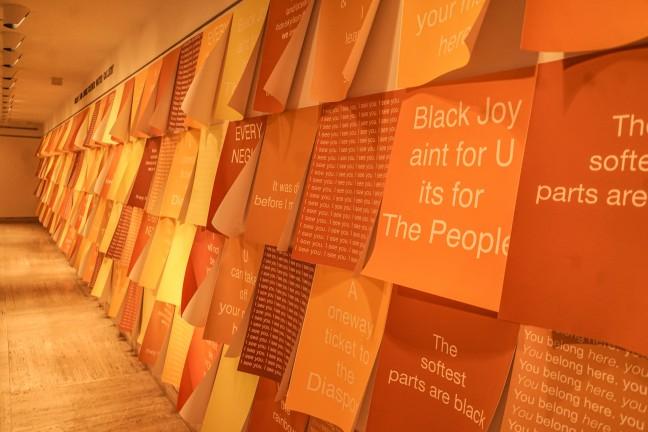“Hoodwinked” is more than just an art installation — it is a journey through the past, present and future of the black narrative.

Located in the Oscar F. Louise Greiner Mayer Gallery of the Chazen Museum, Jay Katelansky transforms the space to relay this powerful message through the use of uniform shades of mustard yellow, tan and brown, poetic text and various multimedia, including music and video.
An omnipresent entity called PhantomNegro narrates Katelansky’s exhibit, who travels through history and time to describe and express the collective trauma of black lives in the United States. In a vehicle reminiscent of science fiction, PhantomNegro depicts the injustices black people face through both dystopic and utopic narratives.
Because of PhantomNegro’s capacity to embody black people of all time periods, genders and ages, it offers a unique and representative look into black dehumanization and pain at a large scale.
While the focus of the exhibit is injustice against black populations, the feeling and attitude of the artist and exhibit does not show hopelessness or sadness. On the contrary, their joy is the overall message and takeaway of the exhibit.
Katelansky wishes to reclaim and restructure this injustice in a way that allows the artist to not only understand, but rewrite the past. Through this rewriting of dominant history and understanding of collective black trauma, Katelansky hopes to instill a feeling of belonging.
On the scattered yellow and brown hued paper covering the wall, quotes are printed and scattered. The text — filled with statements about the black experience — is the means through which PhantomNegro’s sentiment is expressed.

Such statements include “The softest parts are black,” “We are land/ocean/tide/sky/sun/moon,” “They have no chance,” “A oneway ticket to the Diaspora,” “You laughed, I learned to survive,” “It was dim before I met you” and “Black Joy ain’t for U, it’s for The People.”
On the wall is a screen, playing a video of changing text that says, one by one, “undestroyed, remaining, alive, active, existing, undead,” to show the power and perseverance of black populations. The flashing text serves as a means to show that despite the dehumanization of black lives throughout the past and present, their joy is alive and has not been destroyed.

The exhibit at its core is incredibly thought-provoking and human. The bright and warm shades further display the feeling of hope and belonging, along with the upbeat music of black artists played through headphones.
Through a contemporary means and overarching look at black lives in the U.S., “Hoodwinked” opens a necessary conversation and dialogue.
“Hoodwinked” will remain in the Chazen for viewing until May 29.


